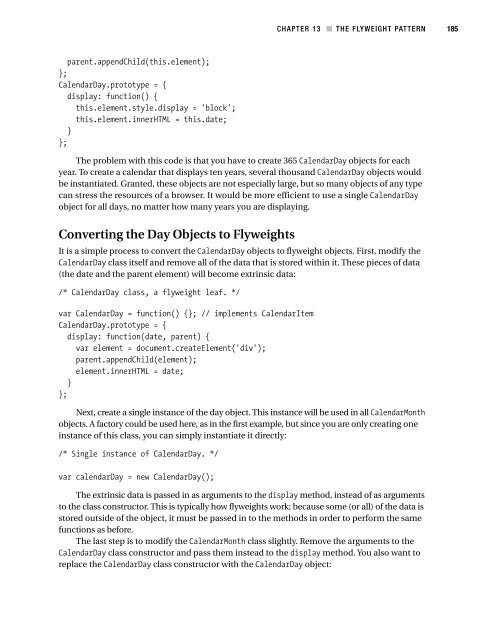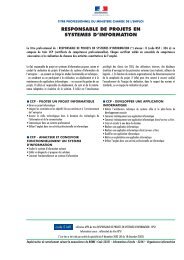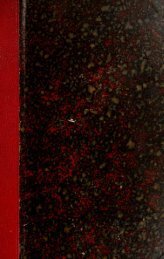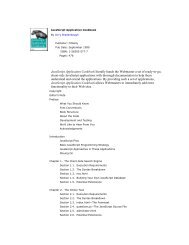Design Patterns
Download - Assembla
Download - Assembla
- No tags were found...
You also want an ePaper? Increase the reach of your titles
YUMPU automatically turns print PDFs into web optimized ePapers that Google loves.
CHAPTER 13 ■ THE FLYWEIGHT PATTERN 185<br />
parent.appendChild(this.element);<br />
};<br />
CalendarDay.prototype = {<br />
display: function() {<br />
this.element.style.display = 'block';<br />
this.element.innerHTML = this.date;<br />
}<br />
};<br />
The problem with this code is that you have to create 365 CalendarDay objects for each<br />
year. To create a calendar that displays ten years, several thousand CalendarDay objects would<br />
be instantiated. Granted, these objects are not especially large, but so many objects of any type<br />
can stress the resources of a browser. It would be more efficient to use a single CalendarDay<br />
object for all days, no matter how many years you are displaying.<br />
Converting the Day Objects to Flyweights<br />
It is a simple process to convert the CalendarDay objects to flyweight objects. First, modify the<br />
CalendarDay class itself and remove all of the data that is stored within it. These pieces of data<br />
(the date and the parent element) will become extrinsic data:<br />
/* CalendarDay class, a flyweight leaf. */<br />
var CalendarDay = function() {}; // implements CalendarItem<br />
CalendarDay.prototype = {<br />
display: function(date, parent) {<br />
var element = document.createElement('div');<br />
parent.appendChild(element);<br />
element.innerHTML = date;<br />
}<br />
};<br />
Next, create a single instance of the day object. This instance will be used in all CalendarMonth<br />
objects. A factory could be used here, as in the first example, but since you are only creating one<br />
instance of this class, you can simply instantiate it directly:<br />
/* Single instance of CalendarDay. */<br />
var calendarDay = new CalendarDay();<br />
The extrinsic data is passed in as arguments to the display method, instead of as arguments<br />
to the class constructor. This is typically how flyweights work; because some (or all) of the data is<br />
stored outside of the object, it must be passed in to the methods in order to perform the same<br />
functions as before.<br />
The last step is to modify the CalendarMonth class slightly. Remove the arguments to the<br />
CalendarDay class constructor and pass them instead to the display method. You also want to<br />
replace the CalendarDay class constructor with the CalendarDay object:











